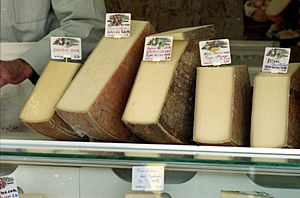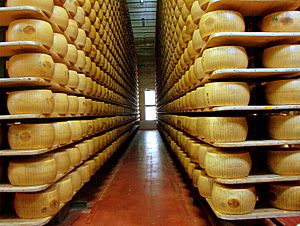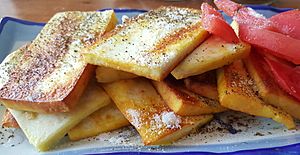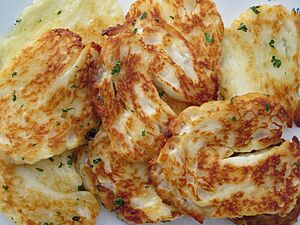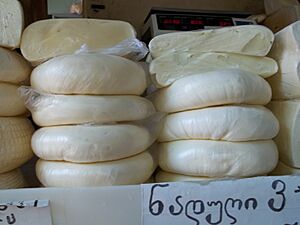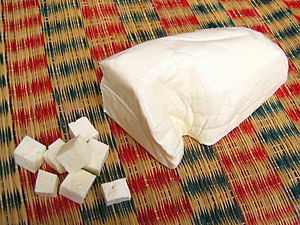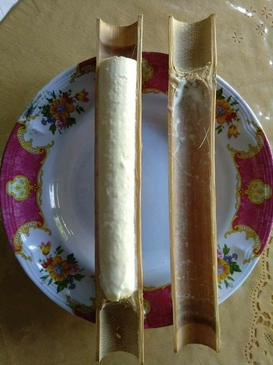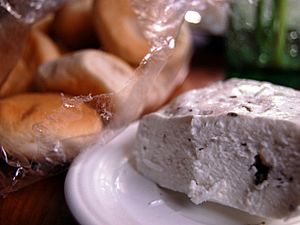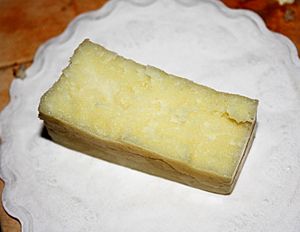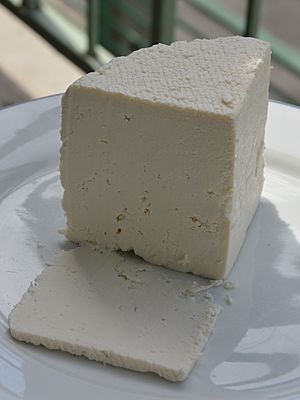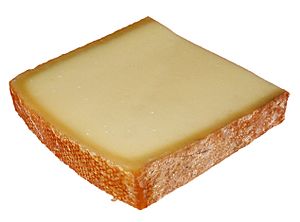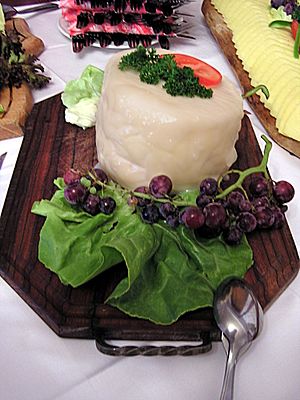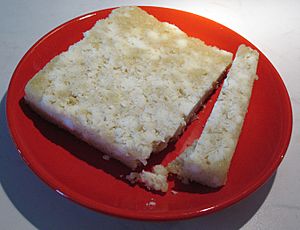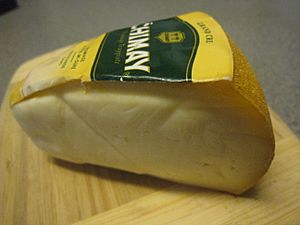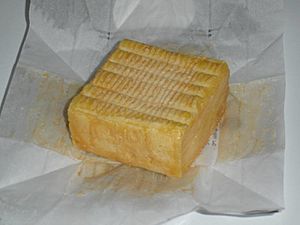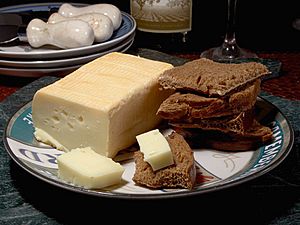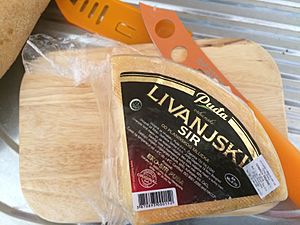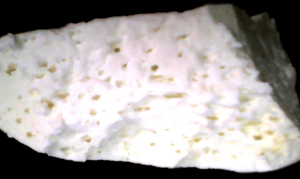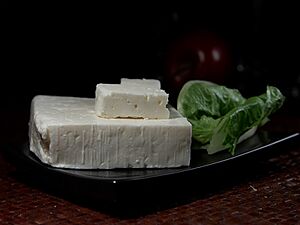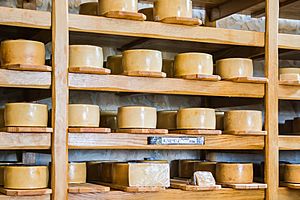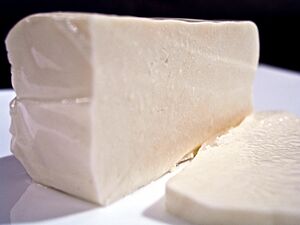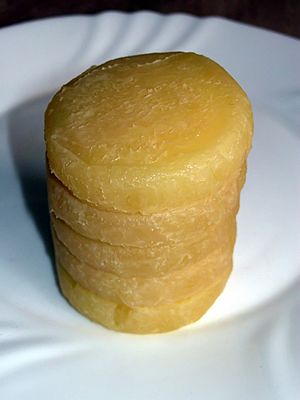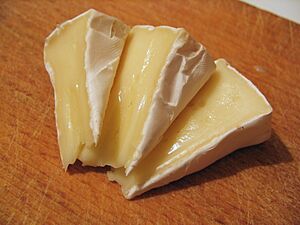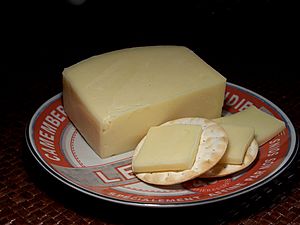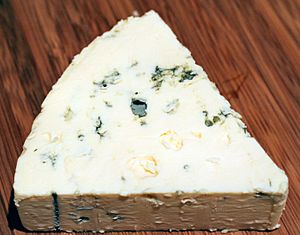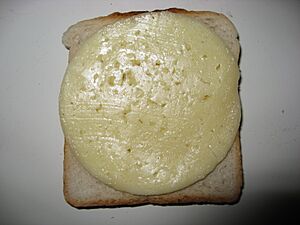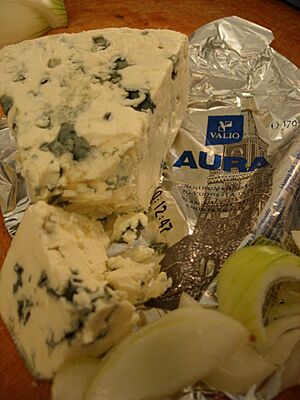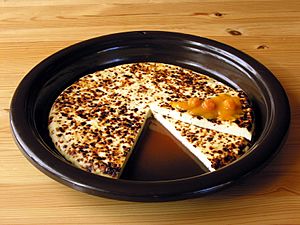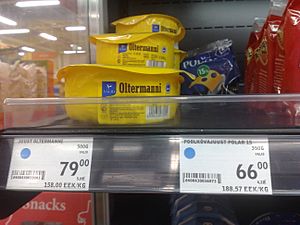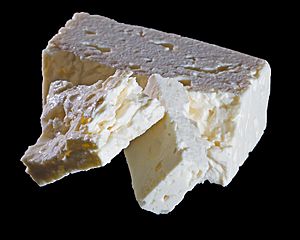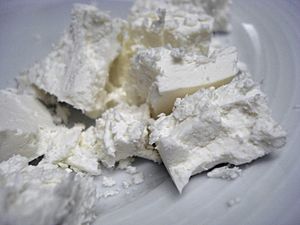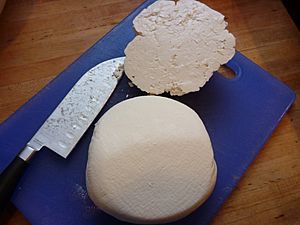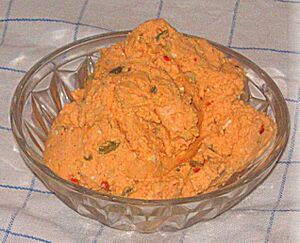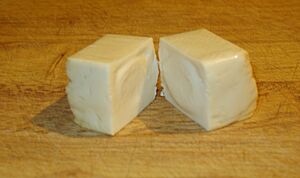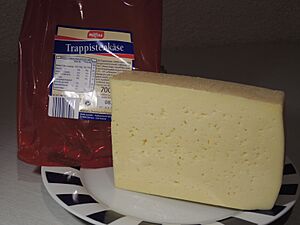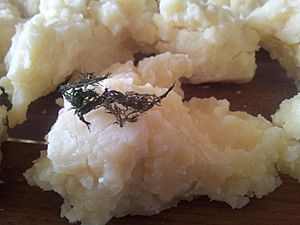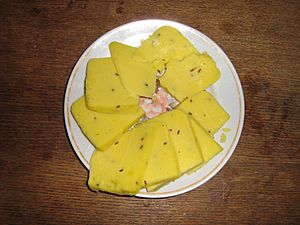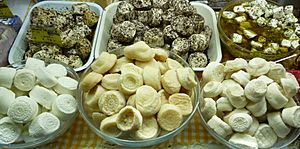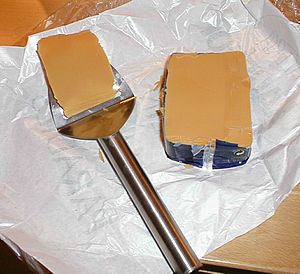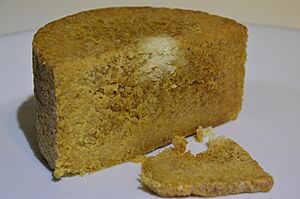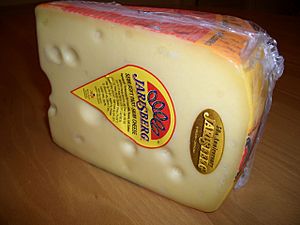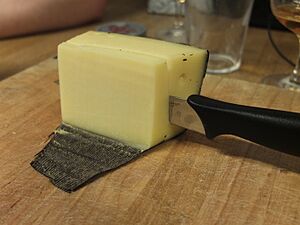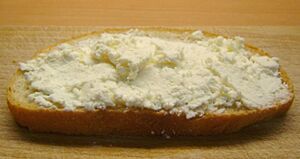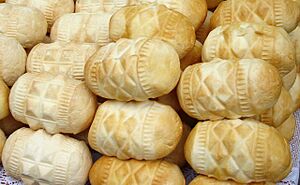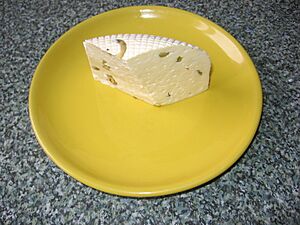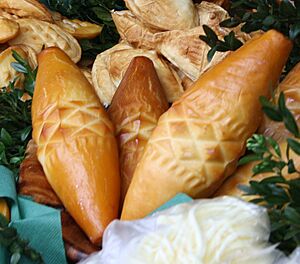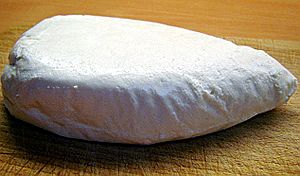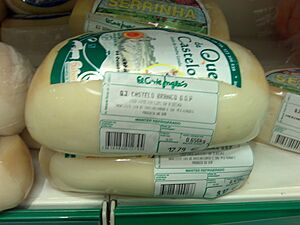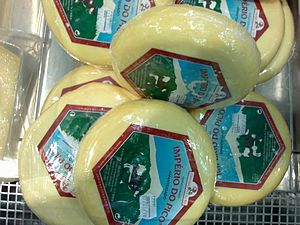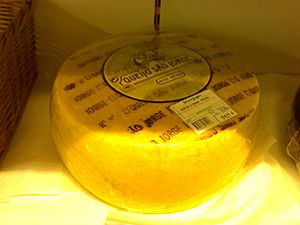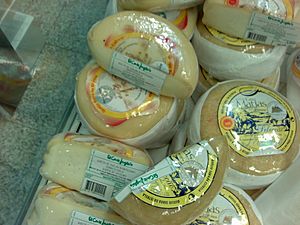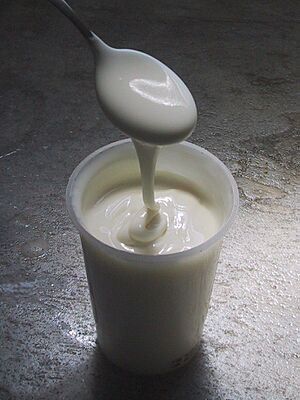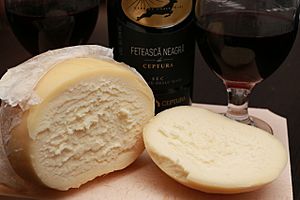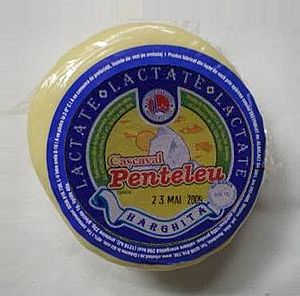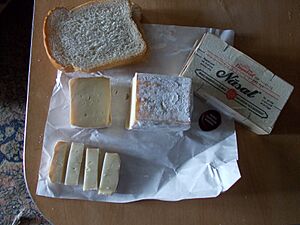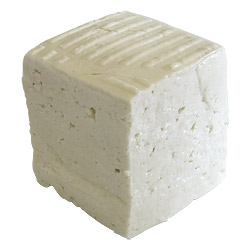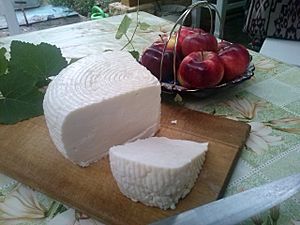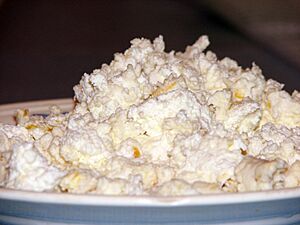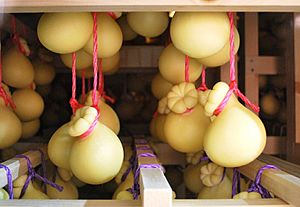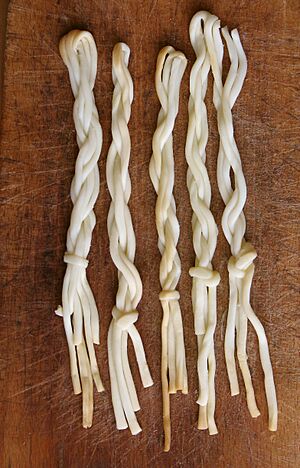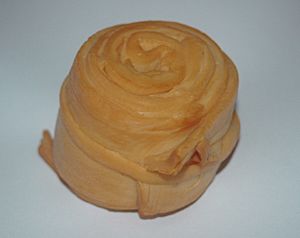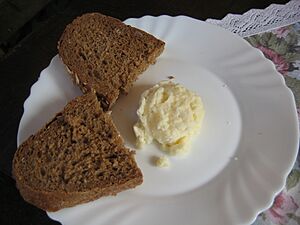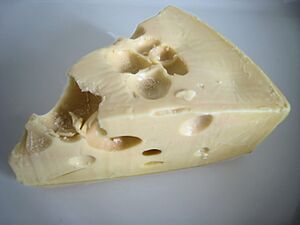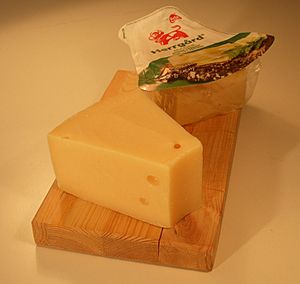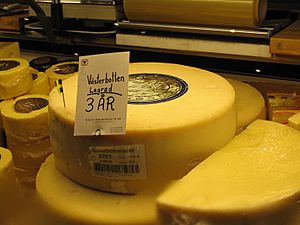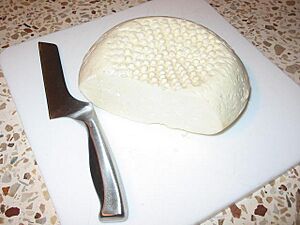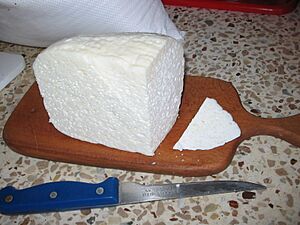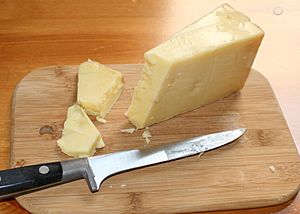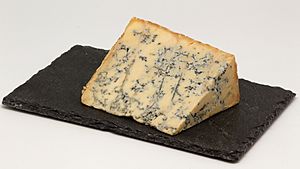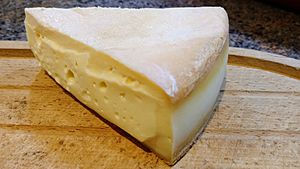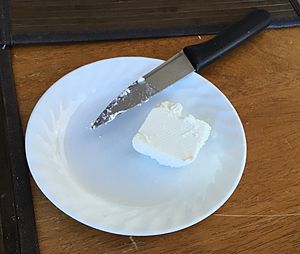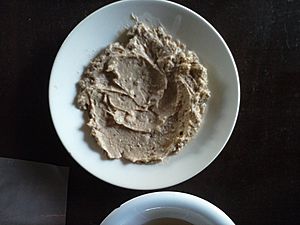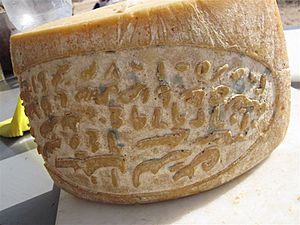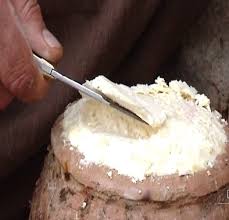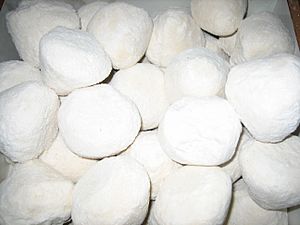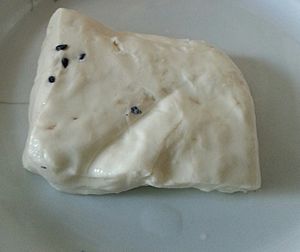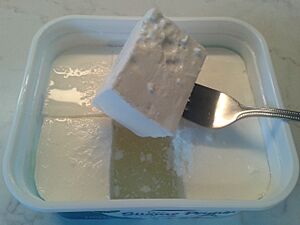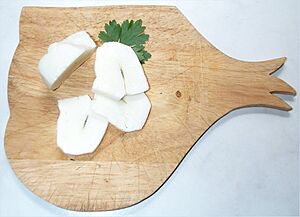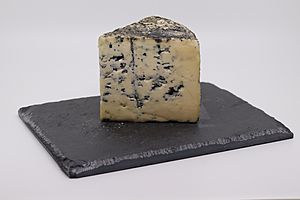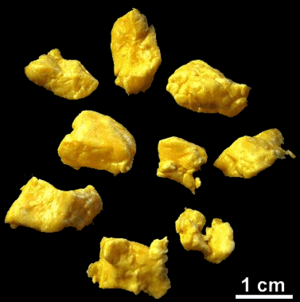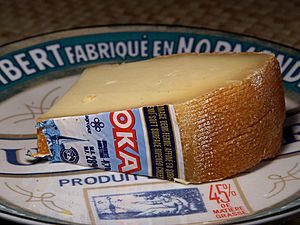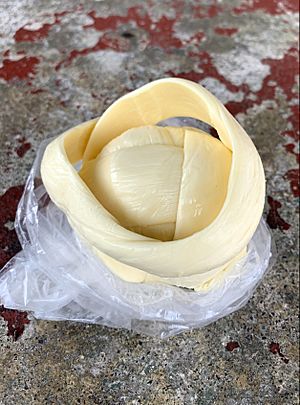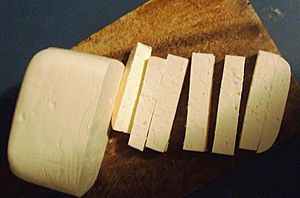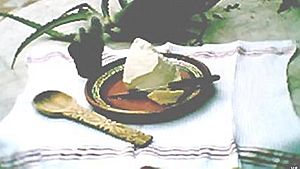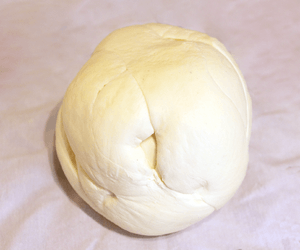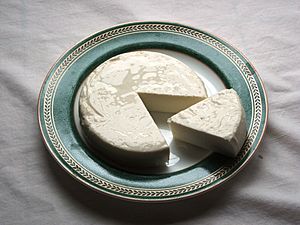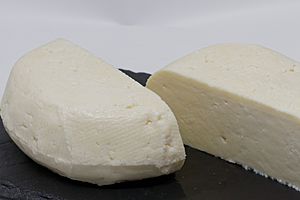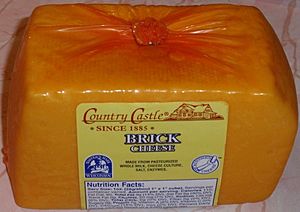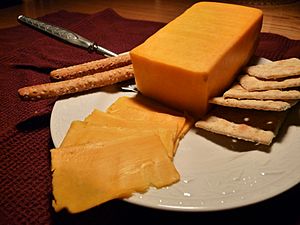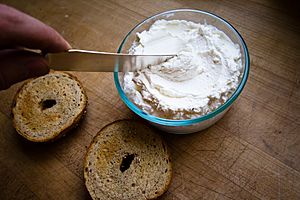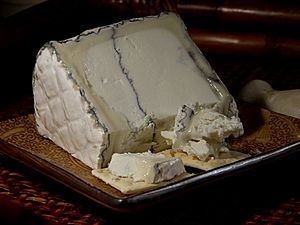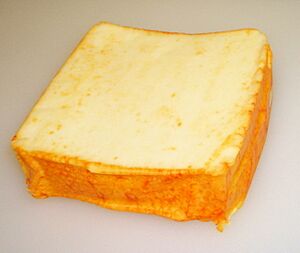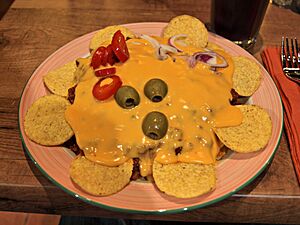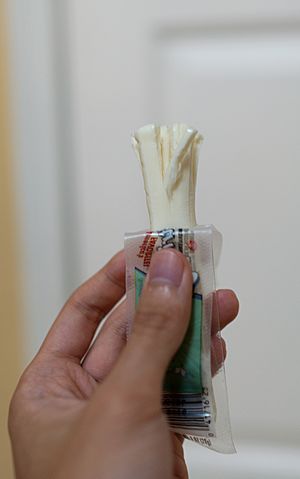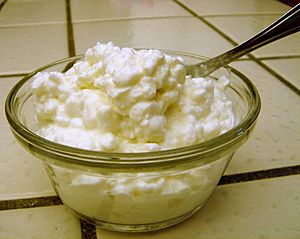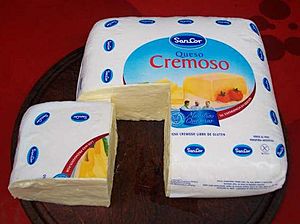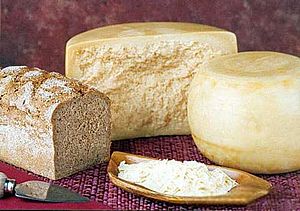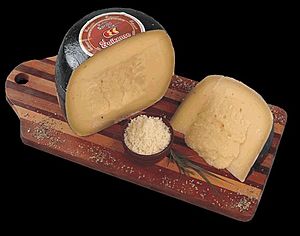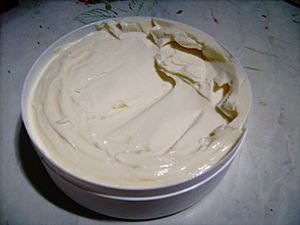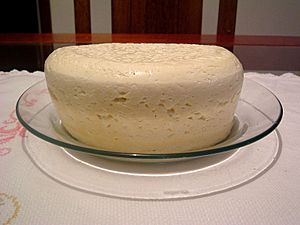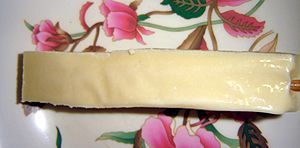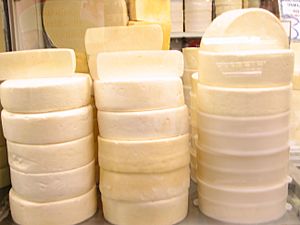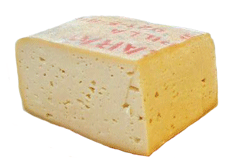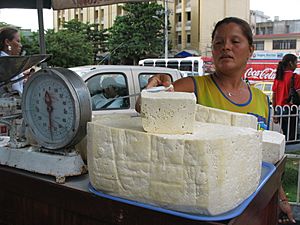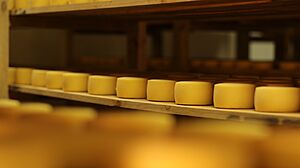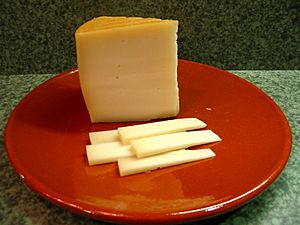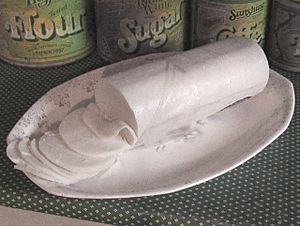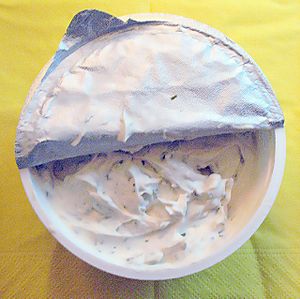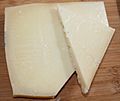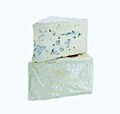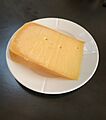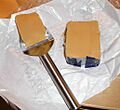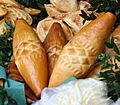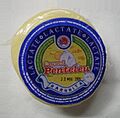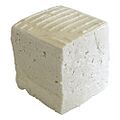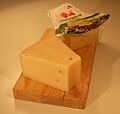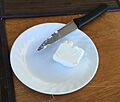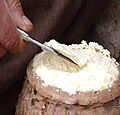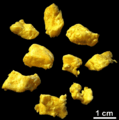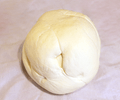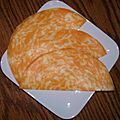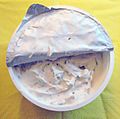List of cheeses facts for kids
Cheese is a super old food, even older than written history! People aren't totally sure where cheesemaking started, but it spread across Europe a long time ago. By the time the Roman Empire was big, making cheese was a very skilled job.
This article lists different kinds of cheeses based on where they come from. Cheese is a food made from milk, and it comes in tons of different tastes, textures, and shapes. There are hundreds of cheeses from many countries. Their styles, textures, and flavors depend on things like:
- What kind of milk is used (cow, goat, sheep, etc.).
- What the animal ate.
- If the milk was pasteurized (heated to kill germs).
- How much butterfat is in it.
- The types of bacteria and mold used.
- How it's made and how long it's aged.
Sometimes, herbs, spices, or even wood smoke are added for flavor. The yellow or red color in many cheeses, like Red Leicester, often comes from adding something called annatto. While most cheeses today come from a specific place or culture, some are known across a whole region, like queso blanco in Latin America.
This list includes different types of cheeses. We only mention brand names if they are a unique kind of cheese.
Contents
- Cheeses from Around the World
- African Cheeses
- Asian Cheeses
- European Cheeses
- Albanian Cheeses
- Austrian Cheeses
- Belgian Cheeses
- Bosnian and Herzegovinian Cheeses
- Bulgarian Cheeses
- Croatian Cheeses
- Czech Cheeses
- Danish Cheeses
- Finnish Cheeses
- French Cheeses
- German Cheeses
- Greek Cheeses
- Hungarian Cheeses
- Icelandic Cheeses
- Irish Cheeses
- Italian Cheeses
- Kosovan Cheeses
- Latvian Cheeses
- Maltese Cheeses
- Moldovan Cheeses
- Montenegrin Cheeses
- Dutch Cheeses
- Norwegian Cheeses
- Polish Cheeses
- Portuguese Cheeses
- Romanian Cheeses
- Russian Cheeses
- Serbian Cheeses
- Slovakian Cheeses
- Slovenian Cheeses
- Spanish Cheeses
- Swedish Cheeses
- Swiss Cheeses
- Ukrainian Cheeses
- United Kingdom Cheeses
- Middle Eastern Cheeses
- North and Central American Cheeses
- Oceania Cheeses
- South American Cheeses
- Other Interesting Cheeses
- Images for kids
- See also
Cheeses from Around the World
African Cheeses
Benin Cheeses
* This is a soft cheese made from cow's milk. * It's often made by the Fulani people in northern Benin. * You can find it sold in many places in Parakou, a city in Central Benin.
Ethiopian Cheeses
* A local cheese that is mild and crumbly. * It doesn't have much flavor on its own. * It's often served with very spicy food to help cool things down.
Mauritanian Cheeses
- Caravane cheese
* This is a special cheese made from camel milk. * It's produced in Mauritania by a company called Tiviski. * Making it is quite hard, but the cheese ends up being low in lactose. * It's also eaten in Senegal.
Asian Cheeses
Armenian Cheeses
* A salty string cheese that might have started in Armenia or Georgia. * It feels a bit like suluguni or mozzarella. * It's made into thick strings, often rolled into a figure eight or a braid.
Bangladeshi Cheeses
- Chhana
* A fresh, soft cheese made from water buffalo milk. * It's crumbly and moist, like a farmers cheese or paneer. * It's used to make yummy desserts like rasgulla.
Chinese Cheeses
Most people in China don't eat a lot of dairy because many can't easily digest milk. However, some groups in places like Inner Mongolia, Tibet, and Yunnan have strong traditions of making cheese.
* A mild, soft Mongolian cheese. * It's made from yak or cow milk.
- Chura kampo
* This is a dried Tibetan cheese and an important part of Tibetan food. * It's made from the leftover curds after boiling buttermilk.
* A firm, fresh goat milk cheese. * It's made in the Yunnan Province by the Bai and Sani groups.
* The picture shows fried rubing cheese.
Cypriot Cheeses
* Usually made from cow milk, but can also use goat or sheep's milk. * It has a smooth feel and a mild salty taste. * It's now made in many parts of the Middle East, like Israel, Palestine, Lebanon, Syria, and Cyprus.
* A fresh, mild cheese made from whey in Cyprus. * Whey is a liquid left over from making other cheeses, like halloumi.
* A Cypriot semi-hard, soft, salty cheese. * It's made from a mix of goat and sheep milk, and sometimes cow milk.
* It doesn't melt easily, so it's great for frying or grilling.
* A hard, salty yellow cheese from sheep or goat's milk. * It's made in Greece and Cyprus. * Its color can be yellow or white, depending on the milk mix.
Georgian Cheeses
- Imeruli
* A "quick cheese" made from cow's milk. * It has a soft, "springy" feel and a salty, slightly sour taste.
* A pickled Georgian cheese from the Samegrelo region. * It has a sour, salty flavor and an elastic feel.
* It's often deep-fried.
- Tenili
* A string cheese made from ewe's or cow's milk. * It's been recognized as an important part of Georgian culture since 2013.
Indian Cheeses
* An Asian cheese that started in a Portuguese colony in eastern India. * It's made by separating curds with lemon juice, then molding and smoking them.
* A fresh cheese common in South Asian cuisine. * It's an unaged, non-melting farmer cheese.
* It's made by curdling heated full-fat milk (often buffalo) with lemon juice, yogurt, or vinegar.
* A fresh, soft cheese made from cow or water buffalo milk. * It's crumbly and moist, similar to farmer's cheese or paneer. * It's used to make desserts like rosogolla.
* Also known as Kiladi or Maish Krej. * It comes from Chenani in Jammu and Kashmir.
Indonesian Cheeses
* A cheese made from buffalo milk using old traditions. * It's known for having a lot of protein and beta-carotene.
Japanese Cheeses
* A soft, creamy white cheese. * It's flavored with mountain cherry leaves. * "Sakura" means "cherry blossom" in Japanese.
Korean Cheeses
- Imsil
* This cheese is made in Imsil Cheese Village, near the town of Imsil. * The village offers programs where visitors can learn how to make cheese.
Malaysian Cheeses
- Susu Masam
* A rare treat made from fermented buffalo's milk. * It comes from Kuala Berang in Terengganu. * The milk ferments inside a bamboo for one to three days until it becomes solid.
* It tastes creamy and sour, like yogurt, and is often eaten with rice.
Mongolian Cheeses
There are two main types of Mongolian cheese (бяслаг). They taste similar, like a mix of mozzarella and unsalted feta cheese.
- түүхий сүүний – a creamy version made by boiling milk and keeping the cream top.
- болсон сүүний – similar, but made without the cream.
- Byaslag
* Made with cow or yak milk. * This cheese has a lumpy curd and a somewhat sour flavor.
Nepalese Cheeses
- Flower of Rajya
* A firm yak's-milk cheese made in Nepal by Tibetan nomads. * The cheese is dry-cured in Tibetan red salt and aged.
* Another yak's-milk cheese, influenced by Tibetan food.
* Depending on how it's made, Chhurpi can be hard and chewy or soft.
Philippine Cheeses
* A soft, white cheese. * It's made from unskimmed carabao's milk, salt, and rennet.
* It has a soft, close texture and a slightly salty taste.
European Cheeses
Albanian Cheeses
* Means "white cheese" and is a type of Balkan sirene. * It's one of the most popular cheeses in Albania, used as a starter or side dish. * It's often served fried or baked with peppers and tomatoes.
* The most popular cheese in Albania after white cheese. * It's seen as a traditional Albanian cheese and is often brought out before main dishes.
* Most dairy companies in Albania make it using cow's or sheep's milk.
* A whey cheese very similar to curd or cottage cheese. * It's usually salted and is a common ingredient for byrek (a type of pastry). * It tastes like ricotta when unsalted.
* A fresh cheese made by boiling whey.
Austrian Cheeses
* A group of cheeses made in the Alps.
* A cheese made from soured-milk from the Vorarlberger Montafon region. * It's a lean cheese, meaning it's very low in fat but high in protein.
* It's been known in Vorarlberg since the 12th century.
- Tyrolean grey (Tiroler Graukäse)
* A strong-flavored, rennet-free cow's-milk cheese from the Zillertal. * It gets its name from the grey mold that grows on its rind.
* It's very low in fat but has a powerful smell.
Belgian Cheeses
- Chimay cheeses
* These are different kinds of cheeses made by Chimay Brewery.
* Some of them are soaked in Chimay Ale.
* An aged cheese made from unpasteurized cow's milk.
* It's traditionally aged in humid caves.
* This cheese started in the 19th century in the old Duchy of Limburg. * It's famous for its strong smell!
* A common way to eat it is in a Limburger sandwich.
Bosnian and Herzegovinian Cheeses
* This cheese is ready after about 60 to 66 days. * It has a full flavor, and older cheeses taste a bit spicy.
* The biggest maker is Mljekara Livno, producing over 500 tons a year.
* A traditional Bosnian semi-hard cow's-milk cheese.
* It's made by the Trappist monks of Mariastern abbey in Banja Luka.
* Produced on Vlašić mountain in central Bosnia, near Travnik. * Originally made from sheep milk, but now also from cow milk or a mix.
* It's a salty, mostly low-fat cheese, white in color.
* Also called Suhi sir or Dimljeni sir. * A very dry, spicy, low-fat smoked cheese.
* It's usually homemade but also produced by companies.
Bulgarian Cheeses
* A type of yellow cheese made from sheep milk, cow milk, or goat milk.
* In many Balkan countries, this word often means "all yellow cheeses."
* A type of salty cheese made in South-Eastern Europe. * It's popular in Serbia, Bulgaria, Romania, Albania, North Macedonia, Greece, and Israel.
* It's made from goat milk, sheep milk, cow's milk, or a mix.
Croatian Cheeses
* A hard, very flavorful sheep milk cheese from the island of Pag.
* It's considered the most famous Croatian artisan cheese.
- Škripavac
* A cheese from Lika made from raw cow's milk.
* It's named after the Croatian word for squeaky because it makes a sound when you bite into it!
Czech Cheeses
- Blaťácké zlato
* A traditional Czech soft cheese made from cow milk.
* It's similar to Bel Paese cheese.
* A soft cheese from Loštice, Czech Republic.
- Hermelín
* A popular cheese in the Czech Republic.
Danish Cheeses
* A semi-soft, aged cow's milk cheese, very common in Denmark.
* It's usually aged for 12 to 52 weeks.
* A strong, blue-veined cheese. * It's a semi-soft creamery cheese, often drum or block shaped.
* It's aged for eight to twelve weeks.
* Also known as cream Havarti, a semi-soft cow's milk cheese. * It has a buttery smell and can be a bit sharp in stronger types.
* The taste is buttery, from sweet to very sweet, and slightly acidic.
* A cow's milk cheese named after the island of Samsø. * It's similar to Emmentaler, but milder and nutty when young. * It's the national cheese of Denmark!
Finnish Cheeses
- Aura
* A Blue cheese made from cow's milk.
* A fresh cheese made from cow's beestings (first milk).
* Sometimes it's made from goat or reindeer milk.
* A semi-soft cow's milk cheese, similar to Danish Havarti.
French Cheeses
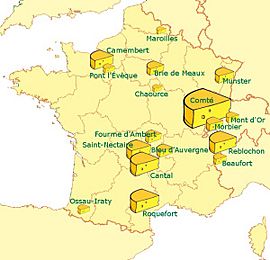
France is famous for its many cheeses! There are hundreds of different kinds, each with its own special taste and way of being made. Many French cheeses have a special "AOC" label, which means they are protected and can only be made in certain areas using traditional methods.
German Cheeses
Germany makes about one-third of all the cheeses produced in Europe!
Greek Cheeses
* A salty white cheese made only in Greece. * It's made from sheep's milk, or a mix of sheep and goat's milk.
* The word "feta" in Greek means "slice."
* A fresh, soft whey cheese from Thessaly.
* A traditional fresh cheese from Crete.
Hungarian Cheeses
- Liptauer or Körözött
* A spicy cheese spread.
* It's made with sheep milk cheese, goat's milk cheese, quark cheese, or cottage cheese.
- Pálpusztai
* A Hungarian soft cow's milk cheese.
* It's known for its strong smell!
* A traditional Hungarian, Bosnian, and Serbian semi-hard cow's-milk cheese.
* It has a mild flavor and melts easily.
Icelandic Cheeses
- Höfðingi
* An Icelandic cheese described as "creamy-soft, almost runny." * It has a white rind and a smooth, mild flavor.
Irish Cheeses
Ireland has many unique cheeses, often made by small, local producers.
Italian Cheeses
Italy is famous worldwide for its many delicious cheeses, often with special protected names like "DOP" (Protected Designation of Origin).
Kosovan Cheeses
* Made in the Šar Mountains region of Kosovo. * It's made from sheep and cow milk.
* It's often added to salads, main dishes, and pitas, or eaten with bread.
Latvian Cheeses
* A mix of raw quark and fresh milk.
* Other ingredients can be added too.
Maltese Cheeses
* A small, round cheese made from sheep's milk, salt, and rennet. * It's often linked to the island of Gozo.
* It comes in many forms.
Moldovan Cheeses
* A type of yellow cheese made from sheep milk.
* In Moldova, this word often means "all yellow cheeses."
* A salty, brined cheese made from sheep milk.
Montenegrin Cheeses
- Kolašinski sir
* A soft, "leafy" cheese made from cow milk in Kolašin, Northern Montenegro. * It gets its special flavor from the plants cows eat in the mountain pastures. * It's very popular and one of the most expensive fresh cheeses in Montenegro.
- Pljevaljski sir
* A semi-soft cheese made from unpasteurized cow milk in Pljevlja, Northern Montenegro. * It gets its unique flavor from being aged in special wooden barrels for at least three weeks.
Dutch Cheeses
The Netherlands is one of Europe's biggest cheese-making countries, with a long history of cheesemaking. You can even see traditional Dutch cheese markets.
Norwegian Cheeses
* A caramelized brown Scandinavian whey cheese.
* It's often called "brown cheese."
* A sour cheese made from skimmed cow's milk.
* A mild cow's-milk cheese with large, regular holes.
- Norvegia
* A Norwegian cow's milk cheese made by the Tine company.
Polish Cheeses
Cheesemaking in Poland goes back a very long time, to 5500 BC! Poland is one of the biggest cheese producers in the world.
* A sheep milk cheese made in Poland, Slovakia, and Ukraine.
* The recipes are a bit different in each country.
* A sheep milk cheese traditionally made in the Podhale region.
- Gołka
* Similar to oscypek, but made with milk from cattle.
* A hard yellow cheese made from cow's milk in eastern Poland.
* It's named after the town of Korycin.
* A smoked sheep milk cheese. * It's made only in the Tatra Mountains region of Poland.
* There's a smaller version called redykołka, known as its "younger sister."
* A Polish blue cheese similar to Danish blue cheeses.
* It's made with cow's milk.
- Twaróg
* Also known as ser biały (white cheese).
* It's similar to cottage cheese.
Portuguese Cheeses
* Named after the city of the same name.
* It's made from goat or ewe milk and has a soft texture.
* From Pico in the Azores. * This cured cheese is made from cow milk.
* It has a salty taste and a strong smell.
* Made on São Jorge Island.
* It's a hard/semi-hard cheese made from unpasteurised cow's milk.
* Made in a mountainous region from sheep's milk.
* Its texture can be very soft and runny when young, or firm when older.
* A milk product from Portugal, sometimes called requesón.
* It's a loose, ricotta-like cheese used for spreads.
Romanian Cheeses
* A salty cheese made from sheep's-milk. * It has a strong flavor and is slightly soft.
* It's often stored in a sheep's stomach or skin, or a pine bark tube.
* This term refers to many types of yellow, medium, and semi-hard cheeses.
* They are made from sheep's or cow's-milk.
* A traditional Romanian cheese from the village of Năsal.
* It's a smear-ripened cheese made from cow's milk.
* A cheese that can be sweet to very salty. * It's made from cow's or sheep's raw or pasteurized milk.
* Fresh telemea is soft, while preserved telemea is harder and very salty.
* A sweet, soft cheese with a sandy feel.
* It's made from boiled whey of cow or sheep milk, very similar to Italian ricotta cheese.
Russian Cheeses
* A crumbly, non-melting, mild fresh cheese from the North Caucasus.
* It's a very famous cheese for Circassians in Russia and the Middle East.
- Tvorog (творог)
* Similar to cottage cheese, but without cream.
Serbian Cheeses
* A type of stretched-curd cheese.
* It's made from sheep's or cow's milk.
* This cheese is said to be the world's most expensive cheese! * It's made from the milk of Balkan donkeys in Serbia.
Slovakian Cheeses
* A sheep milk cheese made in Poland, Slovakia, and Ukraine.
* A type of string cheese made from steamed cheese woven into fine braids.
* Common flavors include salty, smoked, and garlic.
* A traditional Slovakian cheese. * It's a semi-firm, non-ripening, steamed, and usually smoked cheese.
* The cheese is made in strips, which are woven into snail-like spirals.
Slovenian Cheeses
- Mohant
* A soft cheese with a strong flavor.
- Tolminc cheese
* Made with raw cow milk from Tolmin. * It has a sweet and spicy flavor. * This cheese is registered as a Protected Designation of Origin.
Spanish Cheeses
Spain has a rich tradition of cheesemaking, with many unique regional cheeses.
Swedish Cheeses
* A blue cheese made from pasteurized cow's milk.
* It has a light cream color with blue-gray veins and a sharp, salty flavor.
* A semi-hard Swedish cheese made from cow's milk.
* It's similar to Emmental with a mild and nutty taste.
* A semi-hard cheese made from cow's milk.
* The aged cheese has a mild, sweet, nutty flavor and small round holes.
* A very unique cheese produced in Bjurholm, Sweden.
* It's made from moose milk!
* A hard cow's milk cheese with tiny holes and a firm, grainy texture. * It has a strong flavor, described as salty with bitter notes, like Parmesan.
* It must be aged for at least 12 months.
Swiss Cheeses
Switzerland is home to over 450 different kinds of cheese! About 99% of them are made from cows milk. The rest are made from sheep milk and goat milk.
Ukrainian Cheeses
* A sheep milk cheese made in Moldova, Poland, Slovakia, and Ukraine.
- Vurda
* A type of whey cheese.
* A sheep milk cheese.
United Kingdom Cheeses
The British Cheese Board says there are over 700 different British cheeses made in the UK!
* The UK's most famous cheese, and one of the most popular in the world.
* It comes from Cheddar, Somerset.
* Produced in Melton Mowbray, Leicestershire.
* It comes in two types: Blue (with mold for smell and taste) and White (without mold).
* From Dymock, Gloucestershire.
* It's known for its very strong smell!
Middle Eastern Cheeses
Egyptian Cheeses
* A soft white cheese usually made from cow or buffalo milk. * It's salted, heated, and then drained. * It can be eaten fresh or stored in salty liquid for months.
* This cheese makes up about three-quarters of all cheese made and eaten in Egypt.
* A sharp and salty product made by fermenting cheese for several months in salted liquid.
* It's an important food for farmers.
* A hard, aged cheese. * It's salty and crumbly, and sold at different stages of aging.
* It's usually sharp, strong, and has a pungent smell.
Iranian Cheeses
* A brined curd cheese traditionally made in Iran. * It has a sour flavor and is covered in holes. * It's made from sheep's milk.
- Pot Cheese (kuzeh) کوزه
* Also called Kupe paniri. * A salty cheese made from cow's milk and stored in a pot or jug underground to ferment.
* It's common in Northwest Iran.
Levant Cheeses
The Levant is a region east of the Mediterranean Sea that includes Syria, Lebanon, Israel, Jordan, Palestine, and sometimes Cyprus and Hatay in Turkey.
* A white salty cheese named after the city of Acre. * It's often made from cow milk, but can also use goat or sheep's milk.
* It's widely used in desserts like Knafeh.
* Hard, dry laban (a type of yogurt) made from goat or ewe's milk.
* The milk is kept in a fine cloth to make a thick yogurt, then salted and shaped into balls.
* Similar to Greek yogurt, labneh is a strained yogurt common in the Middle East.
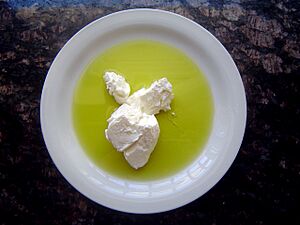
* One of many Palestinian white brined cheeses. * It's named after its origin, Nablus.
* It's a main ingredient in Arabian desserts like Knafeh and Qatayef.
Turkish Cheeses
* A salty, white cheese made from unpasteurized sheep milk.
* It looks a bit grainy and is similar to Greek feta cheese.
* A cheese from Kuzey Kıbrıs.
* A type of cheese from various regions in Turkey.
* A cheese from Van that includes herbs.
North and Central American Cheeses
Canadian Cheeses
* Made by monks at the Benedictine Abbey of Saint-Benoît-du-Lac, Quebec.
* A semi-soft, whole milk blue cheese with deep blue veins.
* Most Canadian Cheddar is made in Ontario. * It's aged for at least three months, but often much longer, up to 10 years.
* These are a key ingredient in poutine, a famous Canadian dish.
* They are best eaten fresh and often "squeak" when you chew them!
* First made by Trappist monks in Oka, Quebec.
* A semi-soft cheese with a unique flavor and smell.
Costa Rican Cheeses
* A popular fresh cheese from Costa Rica.
* It looks like a knotted ball of string cheese.
* A salty young cheese made from cow's milk.
* It comes from Turrialba, Cartago Province.
Mexican Cheeses
* A firm, aged Mexican cheese. * Traditionally made from skimmed goat's milk, but now often from cow's milk.
* It's rolled in paprika for extra flavor.
* A hard, crumbly, salty cheese often used for sprinkling over dishes.
* Named after the state of Oaxaca in southern Mexico.
* A white, semi-hard cheese with a mozzarella-like stringy texture.
- Queso Fresco
* A fresh, white, soft cheese.
- Queso Panela
* A white, fresh, and smooth Mexican cheese made from pasteurized cow's milk.
United States Cheeses
* From Wisconsin. * It's made in a brick shape and ranges from pale yellow to white.
* It has a sweet, mild flavor when young, and gets stronger with age.
* Popular in the Upper Midwest. * They are best eaten fresh (within 24-48 hours) and at room temperature.
* Fresh curds often "squeak" when you chew them!
* From Wisconsin, similar to cheddar but much milder.
* The curds are washed during making to remove milk sugars, which keeps it less acidic.
* A soft, spreadable cheese.
* A mold-ripened cheese from California.
* It has a line of edible white ash in the middle, like Morbier cheese.
* An American white, semi-hard cheese made from cow's milk. * It's known for its mild flavor and slight sweetness.
* A mild, semi-soft cow's milk cheese with a creamy texture and a bright orange rind.
* It's great for melting in sandwiches.
* A general name for processed cheese sauces flavored with peppers and spices.
* It's usually poured on top of nachos or used as a dip.
* A type of Mozzarella with a stringy texture, popular in America.
* A fresh cheese curd product with a mild flavor and a soft, loose texture.
* It's drained but not pressed, so the individual curds stay separate.
Oceania Cheeses
Australian Cheeses
- Tasty cheese
* This is the name for cheddar cheese used in Australia and New Zealand.
South American Cheeses
Argentine Cheeses
* A fresh cheese made from cow's milk.
* It started in Argentina and is similar to Italian cheeses like Crescenza.
* An Argentine cheese, often served with bread.
* Another popular Argentine cheese.
Brazilian Cheeses
* A soft, mild-tasting cheese that can be spread on toast or used in cooking.
* It's one of the most popular "requeijão" (creamy cheese) brands in Brazil.
* Comes in four types: frescal (fresh), meia-cura (half-aged), curado (aged), and queijo padrão ("standard" cheese).
* A firm but very lightweight cheese from Northeastern Brazil.
- Queijo Canastra
* Made from raw cow's milk.
* It has a mildly spicy, full-bodied flavor.
* In Brazil, Requeijão is a type of cream cheese, white in color.
* It has a mild taste and can be creamy or liquid.
Chilean Cheeses
* A cow's milk cheese originally from the Chanco farm. * Now made all over south-central Chile.
* It makes up almost half of all cheese eaten in Chile!
- Panquehue
* A semi-soft cheese from the Andean Aconcagua region. * It's one of Chile's most popular cheeses, similar to Tilsit.
Colombian Cheeses
* A type of Queso Campesino with a lot of salt.
* This helps it stay fresh longer under salt water.
- Queso Paipa
* Made since colonial times in Paipa, a city known for Holstein Milk.
* It's a semi-hard, semi-fat, and semi-cured cheese.
* In Colombia, quesillo is a type of double cream cheese wrapped in a plantain leaf.
* It's originally from the Tolima Department.
Paraguayan Cheeses
* Made with whole cow's milk.
* It's a creamy cheese with a soft texture and a slightly sour flavor.
Peruvian Cheeses
- Queso Andino
* A cheese with a smooth texture and mild flavor.
* A local version of the traditional fresh cheese.
* It's soft and white.
Uruguayan Cheeses
- Colonia
* A soft cheese with a hard rind and a light yellow color. * It has many eyes (holes).
- Danbo
* A type of ripened cheese, similar to Danish danbo cheese. * It's semi-hard, elastic, and has a smooth texture.
- Zapicán
* Made with cow's milk. * It has a firm feel and texture, with some round holes and a smooth but clear flavor.
Venezuelan Cheeses
- Guayanés cheese
* A soft, salty, white cheese from the Guayana Region.
* A type of soft, white cheese (queso fresco) common in Venezuelan food.
* It's often served with a cachapa (a type of pancake).

* A soft, watery, fresh white cheese with big holes. * It's made from pasteurized milk.
Other Interesting Cheeses
Some cheeses were developed in many places on their own, or they aren't actually made from milk!
* Many cultures with strong dairy traditions make different kinds of farmer cheese.
* This is a way of preparing many hard or semi-hard cheeses.
* It uses smoke or smoke flavoring.
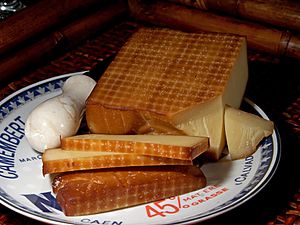
* This is not a dairy product!
* It's a cheese analogue (meaning it's like cheese but made from something else) from soybeans or soy protein.
- Rice cheese
* Like soy cheese, this is a cheese-like product made from rice or rice protein.
Images for kids
-
A cachapa with queso de mano.
-
Smoked Gruyère cheese.
See also
 In Spanish: Anexo:Quesos para niños
In Spanish: Anexo:Quesos para niños
- Brined cheese
- Butter cheese
- Dairy product
- List of blue cheeses
- List of cheese dishes
- List of cheesemakers
- List of dairy products
- List of goat milk cheeses
- List of smoked foods
- List of stretch-curd cheeses
- Sheep milk cheese
- List of water buffalo cheeses
Articles by country
- Cheeses of Mexico
- List of American cheeses
- List of British cheeses
- List of Cornish cheeses
- List of Dutch cheeses
- List of English cheeses
- List of French cheeses
- List of German cheeses
- List of Irish cheeses
- List of Italian cheeses
- List of Polish cheeses
- List of Spanish cheeses
- List of Swiss cheeses
Protected cheeses
- List of European cheeses with protected geographical status
- List of French Protected Designations of Origin cheeses
- List of Greek Protected Designations of Origin cheeses
- List of Italian DOP cheeses
- List of Portuguese cheeses with protected status


